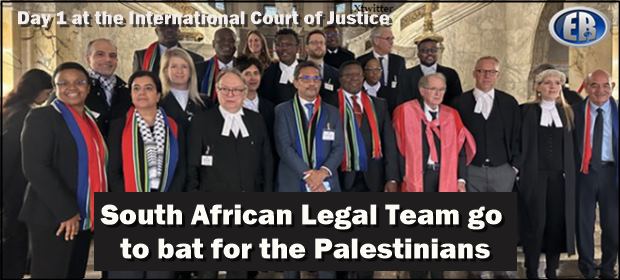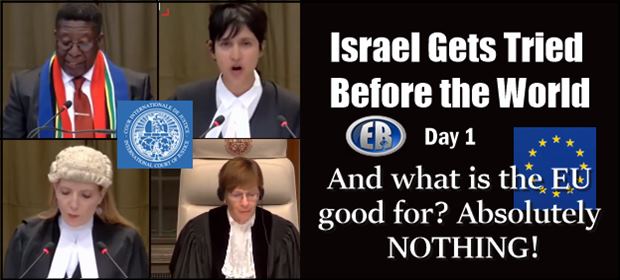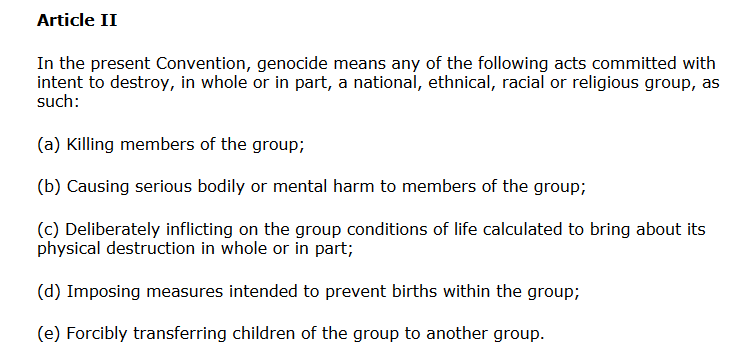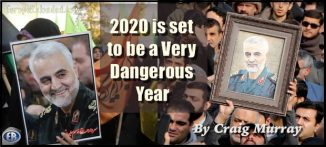
ER Editor: Today is Day 2 of the hearing against Israel for crimes of genocide in The Hague. Below is Craig Murray’s interesting and perceptive account from yesterday, January 11.
See this we published yesterday, with video clips of South African lawyers presenting their case against the Zionist nation. Today it is Israel’s turn to reply to the evidence laid out against them.
South Africa’s genocide case against Israel gets going while Europe remains useless

🇿🇦🇮🇱FULL VIDEO: ICJ – SOUTH AFRICA AGAINST ISRAEL – GENOCIDE – APPLICANTS SUBMISSIONS. 🚨🚨
PART 1: pic.twitter.com/1EWQp8MZQ3
— Dr. Anastasia Maria Loupis (@DrLoupis) January 11, 2024
Those who chose to stand on the right side of history. God bless you all. pic.twitter.com/yNW1SrW7qu
— ※ 𝕄’𝔹𝕒𝕢𝕚𝕣🇵🇸※ (@Emmbee_brown) January 11, 2024
********
Your Man in the Hague (in a Good Way)
CRAIG MURRAY, JANUARY 11 2024
There was every reason for those of us opposing the genocide to have travelled hopefully to the Hague.
In addition to the normal fifteen judges of the court, each of the parties to the dispute, South Africa and Israel, had exercised their right to nominate an additional judge. After the judges filed into the court, proceedings started with these two judges taking an oath of impartiality, which gave us the first Israeli lie of the case before it even started.
The nomination of Aharon Barak as the Israeli judge on the International Court of Justice is extraordinary, given that as President of Israel’s Supreme Court, he refused to implement the ICJ judgment on the illegality of the wall, stating that he knew the facts of the matter better than the ICJ.
Barak has an extremely long history of accepting all forms of repression of Palestinians by the Israeli Defence Force as legal for “national security”, and in particular has repeatedly refused to rule against the longstanding Israeli programme of demolitions of Palestinian homes as collective punishment. That reads across directly to the destruction of civilian infrastructure in Gaza now.
Barak is viewed as a “liberal” in Israel in the constitutional struggle between the judiciary and executive. But that is about the ability of Netanyahu’s corruption to go unchallenged, not about Palestinian rights. By appointing his apparent opponent Barak to the ICJ, Netanyahu has exhibited typical cunning. If Barak rules against Israel, he can claim his domestic opponents are traitors to national security. If Barak rules in favour of Israel, Netanyahu can claim Israeli liberals support the destruction of Gaza.
I expect it is the latter claim we shall be seeing.
I was seated in the public gallery, and watching the seventeen judges occupied much of my time throughout the hearing. Acres have been written about which way who will jump. There is a too easy assumption they will be swayed by their domestic governments. That varies from judge to judge.
The President of the court, Joan Donoghue, is a US State Department, Clinton hack who has never formed an original idea in her life and I should be astonished if she starts now. I half expected her strings to actually be visible, emerging from holes in the hall’s magnificent deep relief panelled wooden ceiling. But others are more puzzling.
There has been no more rabidly anti-Palestinian national elite than that of Germany. Rather than channel feelings of inherited guilt into opposition to genocide in general, they seem to have concluded that they need to promote alternative genocides to make amends. Added to which, the German judge on the ICJ, Nolte, does not come preceded by a liberal reputation. But friends in Munich tell me that Nolte has a particular interest in the law of armed conflict, and is a stickler for intellectual rigour. Their view is that his professional self esteem and intellectual rigour will be the key factors and that only points one way with regard to what the Israeli Defence Force has done so blatantly to the civilian population in Gaza.
On the other hand, there is a Ugandan judge on the ICJ who you might assume would align with South Africa. But Uganda, for reasons which frankly I do not fathom, joined the United States and Israel in opposing Palestine’s membership of the International Criminal Court, on the grounds Palestine is not a real state. Similarly India you might expect to support South Africa as a key member of BRICS. But India also has a Hindu Nationalist government prone to hideous Islamophobia. I haven’t found any evidence of Judge Bhandari’s domestic record on inter-communal issues.
But it has been suggested to me that in this case before the world now, the UN General Assembly may have shot itself in the foot in replacing that particular British judge with the Indian, viewed at the time as a triumph for the developing world in the UN. My point is this, that these questions are very complicated, and much of the analysis I have seen, including from some dear colleagues, has been simplistic mince.
Not only is the Great Hall of Justice not fitted out as a courtroom, for a World Court the public gallery is miniscule. Running along one side of the hall, high enough to kill you if you fell over the balcony edge, it is just two seats deep. Furthermore the fitted theatre style seats are a hundred years old and in a state of near collapse. Your arse is eight inches off the ground and the seats now tilt so your thighs are four inches off the ground and the whole contraption is throwing you forward and over the edge. Rather than fix the seats, the Carbegie Foundation have fixed a strong cable from wall to wall above the balcony rail, acting in effect as a second balcony rail giving six inches more protection.
With one third of the public gallery screened off to house the audio visual projection and webcasting facility, there were just 24 available seats in the public gallery. There were us 14 from the queue and the rest were for representatives of key NGOs and UN organisations, such as Human Rights Watch and the World Health Organisation. They were allowed pens, obviously being judged respectable enough not to kill anybody with them. I may in fact have acquired a pen from one of them at some stage, purely of course to assist them. Or I may not – it is very difficult to know what counts as terrorism these days.
South Africa opened with statements from their Ambassador and their Minister of Justice Ronald Lamola, and they opened with a bang. I rather expected South Africa to start with some soft soap about how much they had condemned Hamas and sympathised with Israel over 7 October, but no. Within the first thirty seconds South Africa had launched both the word “Nakba” and the phrase “apartheid state” at Israel. We had to hang on to our collapsing seats. This was going to be something.
Minister of Justice Lamola came out with the first memorable phrase of the case. Palestinians had suffered “75 years of apartheid, 56 years of occupation, 13 years of blockade”. It was very well done. Before handing over to the legal team, the “agents” of the South African state, in terms of of the Court’s statute, were framing the argument. This injustice, and history itself, did not start on October 7.
There was a second important point of framing. South Africa stressed that in order for the request for “provisional measures” to be granted, it did not need at this stage to be proven that Israel was committing genocide. It only had to be shown that actions of Israel were prima facie capable of falling as genocide within the terms of the Genocide Convention.
The legal team then led off with Dr. Adila Hassim. She outlined that Israel was in breach of the Genocide Convention Article II a), b), c) and d).

On a), killing of Palestinians, she outlined the simple facts without embellishment. 23,200 Palestinians were killed, 70% of them women and children. Over 7,000 were missing presumed dead under the rubble. Over 200 times, Israel had dropped 2,000lb bombs into the very residential areas in southern Gaza into which Palestinians had been ordered to evacuate.
60,000 people were seriously wounded. 355,000 homes had been damaged or destroyed. What could be observed was a substantial pattern of conduct indicating a genocidal intent.
Dr Hassim was notably calm and measured in her words and delivery. But on occasion when detailing atrocities particularly against children, her voice trembled a little with emotion. The judges, who were generally fidgety (on which much more to follow) looked up and paid closer attention at that.
The next lawyer, Tembeka Ngcukaitobi (only South Africa spoke today) addressed the question of genocidal intent. He had perhaps the easiest task, because he could relate numerous instances of senior Israeli ministers, senior officials and military officers referring to Palestinians as “animals” and calling for their complete destruction and the complete destruction of Gaza, emphasising that there are no innocent Palestinian civilians.
What Ngcukaitobi did particularly well was emphasise the effective transmission of these genocidal ideas from senior government to the troops on the ground, who quoted the same phrases and genocidal ideas in filming themselves committing and justifying atrocities. He emphasised that the Israeli government had ignored its obligation to prevent and act against incitement to genocide in both official and popular culture.
He concentrated particularly on Netanyahu’s invocation of the fate of Amalek and the demonstrable effect of that move on the opinions and actions of Israeli soldiers. South African ministers, he said, could not now deny the genocidal intent of their plain words. If they did not mean it, they should not have said it.
The venerable and eminent Professor John Dugard, a striking figure in his bright scarlet gown, then addressed questions of jurisdiction of the court and of the status of South Africa to bring the case – it is likely that Israel will rely heavily on technical argument to try to give the judges an escape route. Dugard pointed out the obligations of all state parties under the Genocide Convention to act to prevent Genocide, and the judgment of the court.
Dugard quoted Article VIII of the Genocide Convention and read out in full Paragraph 431 of the court’s judgment in Bosnia vs Serbia,
This obviously does not mean that the obligation to prevent genocide only comes into being when perpetration of genocide commences ; that would be absurd, since the whole point of the obligation is to prevent, or attempt to prevent, the occurrence of the act. In fact, a State’s obligation to prevent, and the corresponding duty to act, arise at the instant that the State learns of, or should normally have learned of, the existence of a serious risk that genocide will be committed. From that moment onwards, if the State has available to it means likely to have a deterrent effect on those suspected of preparing genocide, or reasonably suspected of harbouring specific intent (dolus specialis), it is under a duty to make such use of these means as the circumstances permit.
I must confess I was very gratified. Dugard’s argument was precisely the same, and quoted the exact same passages and paragraphs, as my article of 7 December explaining why the Genocide Convention should be invoked.
The judges particularly enjoyed Dugard’s points, enthusiastically rustling through documents and underlining things. Dealing with thousands of dead children was a bit difficult for them, but give them a nice jurisdictional point and they were in their element.
Next was Professor Max du Plessis, whose particularly straightforward manner and plainness of speech brought a new energy to proceedings. He said that Palestinians were asking the court to protect the most basic of their rights – they had the right to exist.
Palestinians had suffered 50 years of oppression, and Israel had for decades considered itself above and beyond the reach of the law, ignoring both ICJ judgments and security council resolutions. That context is important. Palestinian individuals have rights to exist protected as members of a group in terms of the Genocide Convention.
South Africa’s case was founded on respect for international law and was based on law and on fact. They had taken the decision not to show the court atrocity videos and photos, of which there were many thousands. Their case was of law and fact, they did not need to introduce shock and emotion and turn the court into a theatre.
This was a shrewd blow by Du Plessis. The hearings were originally scheduled for two hours each side. The South Africans had been told, very late, that was increased to three because the Israelis insist on showing their hour long October 7 atrocity video. But in fact the court’s guidelines reflect a longstanding resistance to this sort of material which must be used “sparsely”. If 23,000 people are dead, it does not add intellectual force to show the bodies, and the same is true of the 1,000 dead from 7 October.
Du Plessis concluded that the destruction of Palestine’s infrastructure that supports human life, the displacement of 85% of residents into ever smaller areas where they were still bombed, all were plain examples of genocidal intent.
But undoubtedly the highlight of the entire morning was the astonishing presentation by Irish KC Blinne Ni Ghràlaigh. Her job was to demonstrate that if the Court did not order “provisional measures”, then irreparable damage would be done.
There are times when a writer must admit defeat. I cannot adequately convey to you the impression she made in that courtroom. Like the rest of the team she eschewed atrocity porn and set out the simple facts plainly but elegantly. She adopted the ploy used by all the South African team, of not using emotional language herself but quoting at length deeply emotional language from senior UN officials. Her outline of daily deaths by type was devastating.
I simply urge you to listen to her. “Each day over ten Palestinians will have one or more limbs amputated, many without anaesthetic”…
I should write more now about the court. The South African delegation sat beside their lawyers on the right of the court, the Israeli delegation on their left, each of about 40 people. The South Africans were colourful with South African flag scarves and keffiyehs draped over shoulders. There was a mixture of South Africans and Palestinians, with Deputy Foreign Minister of the Palestinian Authority Amaar Hijazi prominent, which I was glad to see.
The South African delegation was buoyant and mutually supporting, with a lot of inclusive body language and comparative animation. The Israeli delegation was the opposite of animated. It appeared severe and disdainful – it was as though the members were all under instruction to get on with some work and not particularly notice the proceedings were happening at all. They were generally youthful, and I think cocksure would be a fair description. When Blinne was speaking they seemed particularly keen to ensure everyone could see they were not listening.
You would not think from the body language it was Israel that stands accused. In fact, the only people in the court whose demeanour was particularly dodgy and guilty were the judges. They absolutely looked like they really did not want to be there. They seemed deeply uncomfortable, fidgeted and fumbled papers a lot, and seldom looked directly at the lawyers speaking. During Blinne’s talk, the President of the court suddenly took an intense interest in her startling red iPad, the colour of a particularly bright nail varnish. This came out several times during the hearing, and I could never put these iPad appearances together with what had just been discussed – it was not that cases had just been cited to look up, for example.
Source
************

••••
The Liberty Beacon Project is now expanding at a near exponential rate, and for this we are grateful and excited! But we must also be practical. For 7 years we have not asked for any donations, and have built this project with our own funds as we grew. We are now experiencing ever increasing growing pains due to the large number of websites and projects we represent. So we have just installed donation buttons on our websites and ask that you consider this when you visit them. Nothing is too small. We thank you for all your support and your considerations … (TLB)
••••
Comment Policy: As a privately owned web site, we reserve the right to remove comments that contain spam, advertising, vulgarity, threats of violence, racism, or personal/abusive attacks on other users. This also applies to trolling, the use of more than one alias, or just intentional mischief. Enforcement of this policy is at the discretion of this websites administrators. Repeat offenders may be blocked or permanently banned without prior warning.
••••
Disclaimer: TLB websites contain copyrighted material the use of which has not always been specifically authorized by the copyright owner. We are making such material available to our readers under the provisions of “fair use” in an effort to advance a better understanding of political, health, economic and social issues. The material on this site is distributed without profit to those who have expressed a prior interest in receiving it for research and educational purposes. If you wish to use copyrighted material for purposes other than “fair use” you must request permission from the copyright owner.
••••
Disclaimer: The information and opinions shared are for informational purposes only including, but not limited to, text, graphics, images and other material are not intended as medical advice or instruction. Nothing mentioned is intended to be a substitute for professional medical advice, diagnosis or treatment.





Leave a Reply